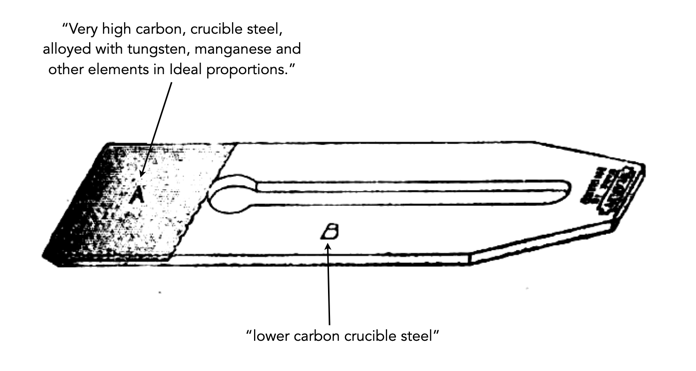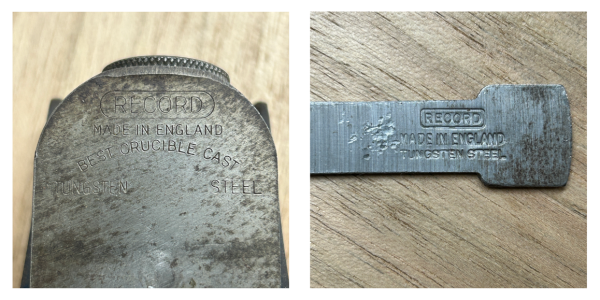Millers Falls were one of the last to the party when it came to block planes, their line of planes debuted in Catalog No.40, January 1929. They introduced 21 different block planes in the initial offering, with no real rhyme or reason with the numbering schema used. The planes were all basically carbon-copies of Stanley planes, at least from the perspective of form and function. In reality Millers Falls didn’t do much in the way of introducing anything new, they merely copied the existing Stanley designs, perhaps with some augmentations with respect to knuckle-lever caps etc. Were their planes better than the likes of Stanley or Sargent? No, they just offered a different perspective. Were they cheaper? The No.16 in 1929 was being sold for $2.20, whereas the equivalent Stanley No.9½ sold for exactly the same price.
My guess would be that Millers Falls already had a very successful tool repertoire, and so they figured that producing planes would only enhance their business. Their one interesting plane was the pressed steel No.206 block plane, which didn’t appear until 1940, although it too was a different interpretation of planes like the Sargent No.5206. The table below describes all of Miller Falls block planes, and their major characteristics. Planes are organized based on how they appeared in the original 1929 catalog.
| No. | Length | Years | Adj. throat | Depth blade adj. | Lateral blade adj. | Bed angle | Stanley Ref-No | Notes |
|---|---|---|---|---|---|---|---|---|
| 16 | 6″ | 1929-1965 | ✓ | ✓ | ✓ | 20° | 9½ | EF |
| 16C | 6″ | 1965-1971 | ✓ | ✓ | ✓ | 20° | 9½ | Depth adjustment modified to sled-type |
| 17 | 7″ | 1929-1964 | ✓ | ✓ | ✓ | 20° | 15 | EF |
| 26 | 6″ | 1929-1944 | ✓ | ✓ | ✓ | 20° | 16 | Same as No.16 with nickel trim LC |
| 27 | 7″ | 1929-1944 | ✓ | ✓ | ✓ | 20° | 17 | Same as No.17 with nickel trim LC |
| 36 | 6″ | 1929-1959 | ✓ | ✓ | ✓ | 20° | 18 | Same as No.16 but with nickel-plated knuckle-joint lever cap. |
| 37 | 7″ | 1929-1959 | ✓ | ✓ | ✓ | 20° | 19 | Same as No.17 but with nickel-plated knuckle-joint lever cap. |
| 56 | 6″ | 1929-1965 | ✓ | ✓ | – | 12° | 60½ | EF, low-angle |
| 56B | 6″ | 1965-1976 | ✓ | ✓ | – | 12° | 60½ | No.56 redesign to accommodate standardized iron. |
| 57 | 7″ | 1929-1964 | ✓ | ✓ | – | 12° | 65½ | EF, low-angle |
| 46 | 6″ | 1929-1942 | ✓ | ✓ | – | 12° | 60 | Same as No.56 but with nickel trim |
| 47 | 7″ | 1929-1948 | ✓ | ✓ | – | 12° | 65 | Same as No.57 but with but with nickel-plated knuckle-joint lever cap. Also Craftsman No.3732. |
| 66 | 6″ | 1929-1944 | – | ✓ | – | 12° | 61 | Same as No.46 but with non-adjustable throat, rosewood knob |
| 07 | 7″ | 1929-1970 | – | ✓ | – | 20° | 140 | rabbet plane (skewed), EF body, rosewood knob, polished nickel trim |
| 55 | 5½” | 1929-1960 | – | ✓ | – | 20° | 103 | EF, screw cap clamp |
| 97 | 7″ | 1929-1960 | – | ✓ | – | 20° | 120 | Longer, and wider than No.55, EF, rosewood knob |
| 75 | 7″ | 1929-1965 | – | ✓ | – | 20° | 220 | longer and wider than No.45, EF, rosewood knob |
| 75B | 7″ | 1965-1968 | – | ✓ | – | 20° | 220 | No.75 redesign to accommodate standardized iron. Sold as Fulton No.5257/3701; Dunlap No.3701. |
| 75-01B | 7″ | 1968-1980s | – | ✓ | – | 20° | 220 | Catalog re-organization. |
| 45 | 5½” | 1929-1964 | – | ✓ | – | 20° | 203 | smaller version of No.75, EF, rosewood knob |
| 3 | 3½” | 1929-1974 | – | – | – | 45° | 100 | No.33 with a curved handle, EF |
| 33 | 3½” | 1929-1974 | – | – | – | 45° | 101 | EF, later gray/red |
| 5 | 5½” | 1929-1964 | – | – | – | 20° | 102 | EF |
| 87 | 7″ | 1929-1964 | – | – | – | 20° | 110 | EF, rosewood knob |
| 68 | 8″ | 1929-1961 | – | – | – | 20° | 130 | double-end block plane (one end rabbet), EF, rosewood knob |
| 700 | 7″ | 1931-1964 | – | – | – | 20° | 1247 | Also Shelburne No.700 M-S |
| 206 | 6¼” | 1940-1959 | – | ✓ | – | 20° | – | pressed steel construction |
| 206B | 6¼” | 1959-1970 | – | ✓ | – | 12° | – | Same as No.206 with 12° bed. |
| 707 | 7″ | 1956-1974 | – | – | – | 20° | 1247 | EF, red LC, grey body, hardwood knob |
| 1455 | 6″ | 1956-1974 | – | ✓ | – | 12° | 61 | No.66 reborn. EF, rosewood knob. No.1455B, redesign to accommodate standardized iron. |
| 8455 | 6″ | 1974-1977 | – | ✓ | – | 12° | 61 | All black. |
| 8707 | 7″ | 1974-1990s | – | – | – | 20° | 1247 | re-numbered No.707 |
| 9775 | 7″ | 1969-1971 | – | – | – | 20° | – | Teflon-coated No.75 |
| 9033 | 3½” | 1974-1990s | – | – | – | 20/45° | H101 | pressed-steel construction |
For a much deeper dive into the intricacies of Millers Falls planes, check out Millers Falls Planes.

















